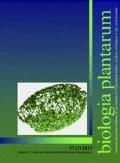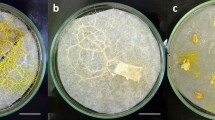Abstract
The production of pectic enzymes byHelminthosporium atypicum and its morphogenesis on different media were studied. It was observed that the fungus produces pectic enzyme (macerating enzyme) adaptively. Increasing concentrations of glucose had an inhibitory effect on enzyme production. Glucose promotes profuse growth and early sporulation whereas presence of pectin slows down the growth and delays sporulation. Delay in sporulation is the effect of presence of pectin and not of the low pH of the medium. It is also suggested that in the case ofH. atypicum low pH of the medium does not allow the fungus to utilize a carbon source as efficiently as at higher pH.
Abstract
Byla studována morfogenese a tvorba pektického enzymu uHelmintosporium atypicum. Bylo zjištěno, že houba vytváří pektický (macerační) enzym adaptivně. Zvýšená koncentrace glukosy potlačovala tvorbu enzymu. Glukosa stimulovala růst a urychlovala sporulaci, zatímco přítomnost pektinu růst brzdila a zpoždovala sporulaci. Zpoždění sporulace je způsobeno přítomností pektinu a nikoliv nízkým pH média, předpokládá se také, že uH. atypicum snížení pH media snižití zdrojů uhlíku.
Abstract
Изучалась продукция пектиназы и морфогенез уHelminthosporium qtypicum выращиваемого на культивационных средах разного состава. Установлено, что продукция нектиназы (мацерирующий фермент) носит адаптивный характер. Повышение концентрации глюкозы действует ингибирующе на продукцию фермента. Глюкоза значительно усиляет рост и приближает срок споруляции, в то время как пектин снижает рост и передвигает фазу спорулирования на более позднее сроки. Задержка споруляции является следствием добавления пектина а не низкого pH культивационной среды. Низкое pH среды по видимому снижает способностьH. atypicum эффективно использовать источники углерода.
Similar content being viewed by others
References
Brown, W.: Studies in the physiology of parasitism 1. The action ofBotrytis cinerea.—Ann. Bot. Lond.29: 313–348, 1915.
Deshpande, K. B.: Studies on pectic enzyme ofRhizoctonia solani Kuhn. 1. Production of protopectinase.—J. biol. Sci.3 (1): 1–8, 1960.
Deshpande, K. B. andDeshpande, K. S.: Contribution to the taxonomy of the genusHelminthosporium 1.—Sydowia (in press) 1966.
Sadasivan, T. S. andSubramanian, D.: Pectic enzymes and plant diseases.—J. Ind. bot. Soc.42 (A): 199–212, 1963.
Wood, R. K. S.: Pectic enzymes secreted by plant pathogens and their role in plant infection..—Symposium Soc. gen. Microbiol.5: 263–392, 1955.
Author information
Authors and Affiliations
Rights and permissions
About this article
Cite this article
Deshpande, K.S., Deshpande, K.B. Pectic enzyme production and morphogenesis inHelminthosporium atypicum . Biol Plant 10, 245–250 (1968). https://doi.org/10.1007/BF02921041
Received:
Issue Date:
DOI: https://doi.org/10.1007/BF02921041




